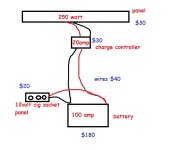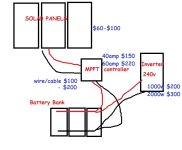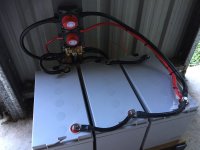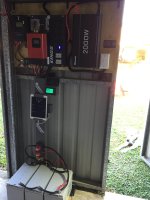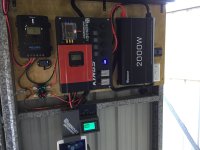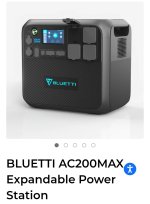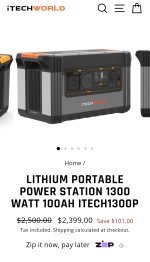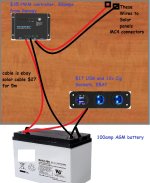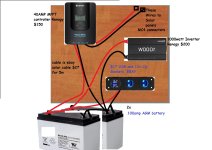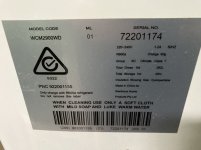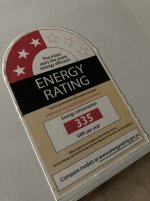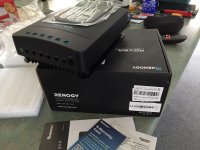Administrator said:
jason1 said:
If some one wants to build something, and doesnt know where to start, im happy to help with advice. there seems tobe allot of people here who have concerns with whats going on with the world who might want some emergency power thats not reliant on fuel. so happy to help with advice on where to start, even help come up with a parts list for you, so you can source that stuff
I'll take you up on that one. I'll get the specifications for my water pump and see what can be built.
I would suggest the optimum would be
60amp controller, would allow 800watts of panels with a total of 150v
https://au.renogy.com/rover-li-60-amp-mppt-solar-charge-controller/
as panels have avolt rating on them, so you have three main ratings, Amps, watts and Volts
the amps will stay the same when joining in panels in series, watts and volts get added together when joined in series. so both watts and amps will be multiplied by the number of panels in the chain. The total number of volts and watts will need tobe at max the 800watts and 150volts the controller is rated to. I can explain how to join in series.so when buying panels you look at the rear of them and do that calculation.
The MPPT controller will convert all that wattage,voltage and amperage collected by the panels into higher amps, It brings down the high volts into lower volts of say 14volts towards your battery banks and coverts it all into a max of 60amps. thats the charging part of an MPPT controller, why its a 60amp controller.
you could get away with a 40amp controller, but the 60amps would power your pump easy off the sun and meaning in full sun you could likely see it charge your battery slightly and still run the pump at same time, the 40amp wouldnt, so it would only charge a battery when the pump stops running. but if the pump doesnt run often and for long then that helps with charging and so its possible with the 40amp you could keep up and charge in those periods the pump isnt running, but obviously the 60amp would be better with the extra solar panels it can take.
if that makes sense?
there is also the option of going a 40amp controller and if that doesnt do the job, you can add a second controller like a 20amp MPPT and running extra panels off that. you can run two charge controllers. I run two controllers on my system to the same battery bank. so you always have room for more upgrades in the future with out replacing entire system.
as for inverter it seems like you could get away with 1000watts if your only running one item at a time, it may run your fridge as well but would be at max, which is not optimal.
the 2000watts would easily do both, https://au.renogy.com/renogy-2000-12v-to-230v-pure-sine-wave-inverter-with-ups-function/
on a 12v system I wouldnt run any more than 2000watts of inverter, any more really puts pressure on a battery bank and its cables.
both inverters have USP function and so you could plug in 240v into inverter and when power cuts off it switches to battery bank.
now there is this beast of an inverter, if you have the budget, its UPS, but also charges the battery bank off mains. I mean you can buy a smart charger from Kickass for $100 to keep batteries topped off mains. but this is a good option for a single unit to be a UPS, battery mains charger and Inverter.
https://au.renogy.com/2000w-12v-pure-sine-wave-inverter-charger-w-lcd-display/
so there is a few options for the inverter type and size
I would say for batteries between at least 300ah to 400ah, lithium allows you to use more of that battery storage over say AGM, but they are way more expensive.
so lithium is best option but most expensive option. AGM is fine
running 12v you dont want tobe running much more than that 400ah, if wanting togo bigger you would look at say 24-48V battery system which that 60amp controller can handle, you can turn 12volt batteries into a 48 volt battery bank by the way you joined the batteries together.
you would need a different inverter to run off 48v battery bank, as that one wouldnt handle 48v
this is why I questioned the use of that ecoflow portable battery bank handling your pump for long periods of time. it has a big inverter but not much storage and doesnt allow many amps of volts from solar arrays.
Wiring, the inverter will have the cables needed.
you would need the Mc4 plug solar cable I posted previously for you solar to controller.
you would need some very heavy battery cable to join batteries.
when your talking such high amps you would wire in an emergency isolator switch. which are about $20 on ebay.i can supply link to one I use
I would also use a breaker switch which are about $15-$20.
so
if you could do say 60amp controller
you could have say
800watts solar
300-400ah batteries which is equal to 3600Wh-4800Wh
1000-2000watts of 240v power
with room to upgrade. and fancy helpful things are the following
renogy also has Bluetooth devices, so you can monitor your system remotely.
if you want that feature when you buy the MPPT you just select the bluetooth device, thats usually like $30 extra.
Now this is a very useful item, the battery monitor which reads your battery info by a shunt. this type of monitor is the best. everything is hooked upto the shunt, which is located right at the battery, so everything that draws power, or puts power into the batteries is being read as a total. so you can see how many Amp hour is left in your battery
https://au.renogy.com/500a-battery-monitor/
hope that gives you a bit of an idea. if you want advice at wiring stage I can help you with that.
for solar panels of that a number, you would permanently mount them, either make a structure to mount them to, put on a shed roof or house roof, in a location that gets the best sun.
nothing stopping you building the system on a custom trolley so you can, unplug solar from the battery bank via Anderson plug or MC4 and move the battery bank with inverter around to different locations to use the battery and inverter elsewhere to power things, then return it to the solar panels to charge. but if you were going to power that pump Id suggest having panels close to the pump area, so running solar while operating the pump. as thats a power thirsty item, and you would likely want to use the sun power to its max.
this would be as close to as cheap as you could get for a system this size, again you dont have to use renogy you could us EPEVER or Kickass for around the same money, they are good reliable brands also But the Renogy Inverters are good, its hard to find better at that price point or even slightly above.
the wiring would be fairly simple as shown in previous post with MPPT and multiple batteries, just with some breakers added in and an isolation switch. I could draw you a diagram with where to put all that stuff, if you wanted to build a system,
any way i hope that gives you a bit of an idea on what is needed and what the main parts would cost


